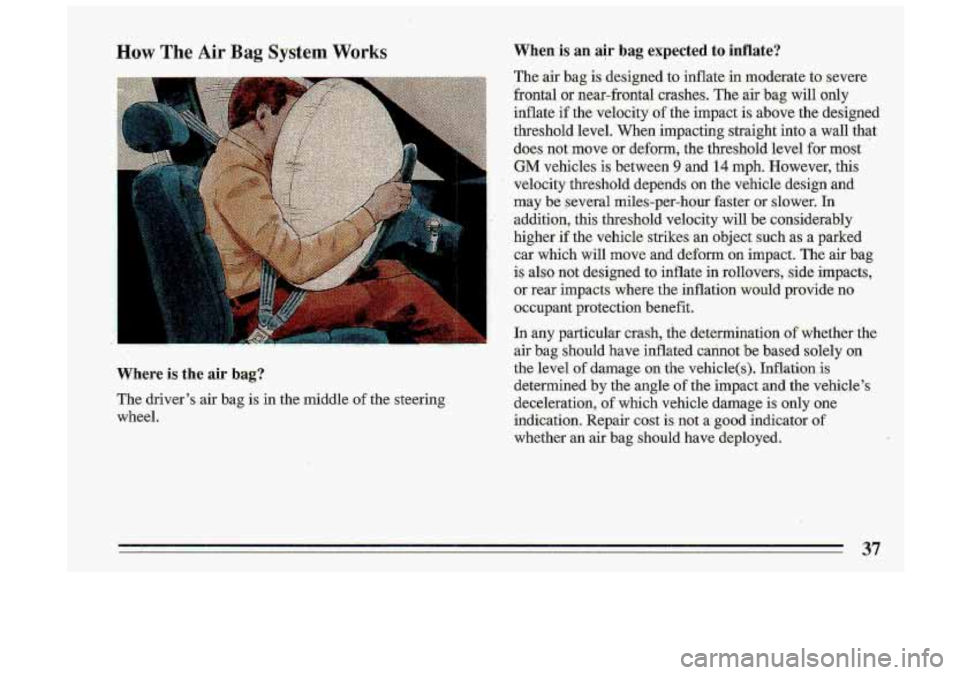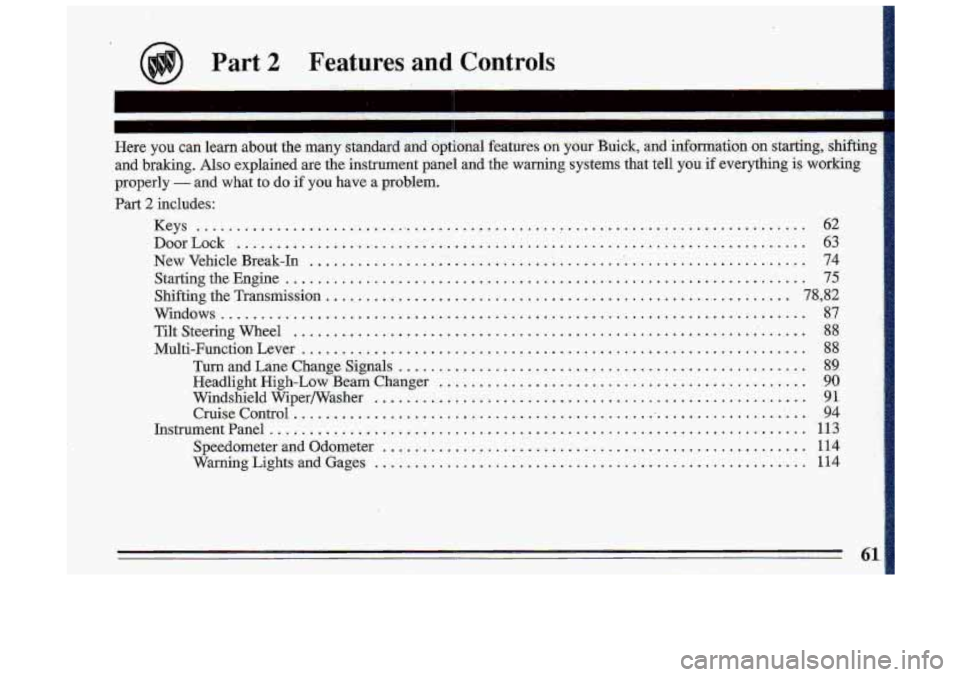Page 25 of 340
Take the simplest “car.” Suppose it’s Just a seat on
wheels.
Put someone on it.
23
>
Page 39 of 340

How The Air Bag System Works
Where is the air bag?
The driver’s air bag is in the middle of the steering
wheel.
When is an air bag expected to inflate?
The air bag is designed to inflate ,in moderate to severe
frontal or near-fontal crashes. The air bag
will only
inflate if the velocity of the impact is above the designed
threshold level. When impacting straight into a wall that
does not’move or deform, the threshold level for most
GM vehicles is between 9 and 14 mph. However, this
velocity threshold depends
on the vehicle design and
may be several miles-per-hour faster or slower. In
addition, this threshold velocity will be considerably
higher
if the vehicle strikes an object such as a parked
car which will move and defonn
on impact. The air bag
is also not designed to inflate in rollovers, side impacts,
or rear impacts where the inflation would provide no
occupant protection benefit.
In any particular crash, the determination of-whether the
air bag should have inflated cannot be based solely on
the level
of damage on the vehicle(s). Inflation i,s
determined by the angle of the impact and the vehicle’s
deceleration,
of which vehicle damage is only one
indication. Repair cost
is not a good indicator of
whether an air bag should have deployed.
37
Page 63 of 340

Part 2 Feat.ures and Controls
n .
Here you can learn about the many standard and optional features on your Buick, and infom.ation on starting. shifting
and braking
. Also explained are the instrument panel and the warning systems that tell you if everything is working
properly
. and what to do if you have a problem .
Part 2 includes:
Keys
........................................................................\
..... 62
DoorLock ....................................................................... \
63
New Vehicle Break-In ............................................................... 74
Starting the Engine
................................................................. 75
Shifting the Transmission
.......................................................... 78, 82
Windows ........................................................................\
. 87
TiltSteeringWheel
................................................................ 88
Multi-IFunctionLever ............................................................... 88
TurnandLaneChangeSignals ................................................... 89
Headlight High-Low Beam Changer .............................................. 90
Windshield WiperWasher
....................................................... 91
Cruise Control
.................................................................. 94
Instrument Panel
................................................................... 1 13
Speedometer and Odometer
..................................................... 114
Warning Lights and Gages
...................................................... 114
61
.
Page 74 of 340
Theft
Vehicle theft is big business, especially in some cities.
Although your Buick has
a number of the€t deterrent
features, we know that nothing we put on it can make
it
impossible to steal. However, there are ways y6U can
help.
Kev in t~he ignition: If you walk away from your
vehicle with the keys inside, it's an easy'target for joy%..
riders or professional thieves - so don't do it. wyqw. .:: %3: F: ;-;.::. *.'%(:.
When you park your Buick and open'the diiver 's'door,
you'll hear a tone reminding you'to remove your key
from the ignition and take it with you.' Always
do this..
Your steering wheel will be locked, and
so will your
ignition and transmission. And remember to lock the
doors.
.. .L: . . *:*.a ;*;,,,
Parking at Night: Park in a lighted spot, close all
windows and lock your vehicle. Remember to keep your
valuables out
of sight. Put them in a storage area, -or take
them with you.
Page 83 of 340
Limited-Slip Rear Axle
If you have this feature, your rear axle can give you
additional traction on snow,, mud, ice, sand or gravel. It
works like a standard axle most of the. time; but when
one of the rear wheels has
no traction and the other
does, the limited-slip feature will allow the wheel with
traction to move the vehicle.
Parking Brake
To set the parking
brake:
Hold the regulaT brake
pedal down- with y,our
rightfoot. Push down the
1: parkng. brake pedal with
1;. -your lefi-foot.. rf the
1:. 'ignition is on, the brake
i~ ,system warning light will
come
on.
Page 84 of 340
,. To release the parking
brake:
Hold the regular brake
pedal down. Pull the brake
release lever.
,.( r
Jf YOU are .on a hill: See “Parking on Hills” in the Index.
That section
shows how to turn’ yoax front wheels.
If you are towinp a trailer and are.parking’on any hin:
‘See
“Towing a Trailer” in the Index. That section shows
:what
to do first to keep the trailer from moving.
. .(*
Shifting Into P (Park)
ci 99
It can be dangerous to get out of your vehicle if
the shift lever is not fully in T” (Park) with the
parking brake firmly
set. Your vehicle can roll.
If you have left the engine running, the vehicle
can move suddenly. You or others could be
, injured. To be sure your vehicle won’t move,
when you’re
on fairly level ground, use the
steps that follow.
If you are parking on a hill, ~r . 11
if you’re pulling a trailer, also see “Parking Or-.
Hills” or “Tcl ..:nu a Trailer” in the Index.
I
1 .. Hold the brake pedal down with your right foot and
set the parking brake.
Page 96 of 340
Cruise Control (Option) ,* .. :. .> ..
..
";. ?y . ..
I you can't drive safely at a steady speed.
So, don't use your Cruise Control on
winding roads or
in heavy traff'
Cruise Control can be dangerous
slippery roads. On such roads, fast
changes in tire traction can cause
needless wheel spinning, and you
COI
lose control. C tt I ~ = P ise ^ontrol on
I
lippel- poads
With Cruise Control, you can maintain a speed of about To Set. Cruise Cc-trol
25 mph (40 km/h) or more without keeping your foot on 1. Move the Cruise
the accelerator. This can really help on long trips. Cruise Co\
ntrol switch 'to
"ON."
Control does not work at speeds below about 25 mph ;.'
When you apply your brakes, the Cruise Control shuts i. 'I
.Off.
NOTE: On the Estate Wagon, if the tailgate window is
not completely closed the cruise control will not work.
(40 k-yn/h).
Page 173 of 340
An emergency like this requires close attention and a
quick decision.
If you are holding the steering wheel at
the recommended
9 and 3 o'clock positions, you can
turn it a full 180 degrees very quickly without removing
either hand. But you have to act fast, steer quickly, and
just as quickly straighten the wheel once you have
avoided the object.
You must then be prepared to steer
back to y.our original lane and then brake
to a controlled
stop.
Depending on your speed, this can be rather violent
for
an unprepared driver. This is one of the reasons driving
experts recommend that you use your safety belts and
keep both hands on the steering wheel.
The fact that such emergency situations are .always
possible is a good reason to practice defensive driving at
all times.
171